Subaru Crosstrek Owners Manual: Rear center seatbelt
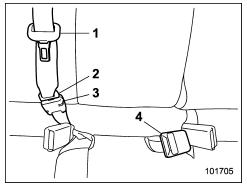
- Center seatbelt tongue plate
- Connector (tongue)
- Connector (buckle)
- Center seatbelt buckle
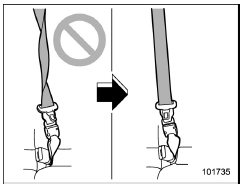
WARNING
Fastening the seatbelt with the webbing twisted can increase the risk or severity of injury in an accident.
When fastening the belt after it is pulled out from the retractor, especially when inserting the connector's tongue plate into the mating buckle (on right-hand side), always check that the webbing is not twisted.

WARNING
- Be sure to fasten both tongue
plates to the respective buckles.
If the seatbelt is used only as a shoulder belt (with the connector's tongue plate not fastened to the connector's buckle on the right-hand side), it cannot properly restrain the wearer in position in an accident, possibly resulting in serious injury or death.
- The head restraint is not intended
to be used at the lowest position.
Before sitting on the seat, raise the head restraint to the extended position. Otherwise, in an accident, serious injury or death could result.
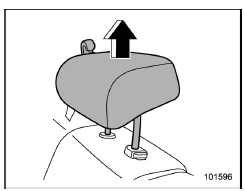
1. Raise the head restraint to the extended position. Do not remove the head restraint.

2. Remove the tongue plate from the belt holder on the right side of the cargo area and pull out the seatbelt slowly.

3. After drawing out the seatbelt, pass it through the belt guide as follows: First insert one edge of the belt into the open gap in the belt guide; then slide the rest of the belt in, so that the whole belt fits inside.

4. After confirming that the webbing is not twisted, insert the connector (tongue) attached at the webbing end into the buckle on the right-hand side until a click is heard.
- If the belt stops before reaching the buckle, return the belt slightly and pull it out more slowly.
- If the belt still cannot be unlocked, let the belt retract slightly after giving it a strong pull, then pull it out slowly again.

5. Insert the center seatbelt tongue plate into the center seatbelt buckle marked "CENTER" on the left-hand side until it clicks.
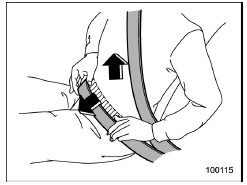
6. To make the lap part tight, pull up on the shoulder belt.
7. Place the lap belt as low as possible on your hips, not on your waist.
Unfastening the seatbelt

1. Push the release button of the center seatbelt buckle (on the left-hand side) to unfasten the seatbelt.
NOTE
When the seatback is folded down for greater cargo area, it is necessary to disconnect the connector.
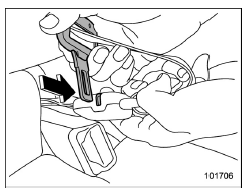
2. Insert a tongue plate or other hard pointed object into the slot in the connector (buckle) on the right-hand side and push it in. The connector (tongue) plate will then disconnect from the buckle.
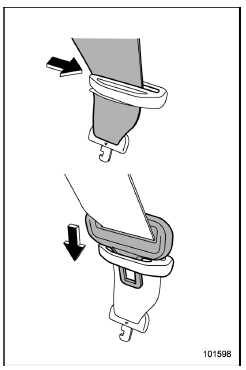
3. Allow the retractor to roll up the belt.
You should hold the webbing end and guide it back into the retractor while it is rolling up. Insert the connector (tongue) into the belt holder.

CAUTION
- Do not allow the retractor to roll
up the seatbelt too quickly.
Otherwise, the metal tongue plates may hit against the trim, resulting in damaged trim.
- Have the seatbelt fully rolled up so that the tongue plates are neatly stored. A hanging tongue plate can swing and hit against the trim during driving, causing damage to the trim.
 Rear seatbelts (except rear center seatbelt)
Rear seatbelts (except rear center seatbelt)
1. Sit well back in the seat.
2. Pick up the tongue plate and pull the
belt out slowly. Do not let it get twisted.
If the belt stops before reaching the
buckle, return the belt slightly and ...
 Seatbelt maintenance
Seatbelt maintenance
To clean the seatbelts, use a mild soap
and lukewarm water. Never bleach or dye
the belts because this could seriously
affect their strength.
Inspect the seatbelts and attachments
including the ...
Other materials:
Dtc p0072 ambient air temperature sensor circuit "a" low
ENGINE (DIAGNOSTICS)(H4DO) > Diagnostic Procedure with Diagnostic Trouble Code (DTC)DTC P0072 AMBIENT AIR TEMPERATURE SENSOR CIRCUIT "A" LOWDTC detecting condition:Immediately at fault recognitionCAUTION:After servicing or replacing faulty parts, perform Clear Memory Mode Clear Memory ...
Location
HVAC SYSTEM (HEATER, VENTILATOR AND A/C) > Relay and FuseLOCATIONMain fuse boxA/C relay(A)Relay & fuse boxFuse 15 A (blower motor relay)(B)Fuse 15 A (blower motor relay)(C)Fuse 7.5 A (A/C control panel, A/C relay, sub fan relay, pressure switch and blower motor relay)(D)Fuse 7.5 A (A/C contro ...
Dtc u1500 keyless uart com. Malfunction
BODY CONTROL SYSTEM (DIAGNOSTICS) > Diagnostic Procedure with Diagnostic Trouble Code (DTC)DTC U1500 KEYLESS UART COM. MALFUNCTION1. MODEL WITHOUT KEYLESS ACCESS WITH PUSH BUTTON START SYSTEMDTC detecting condition:UART between the TPMS & keyless control module or keyless entry CM and the bod ...
